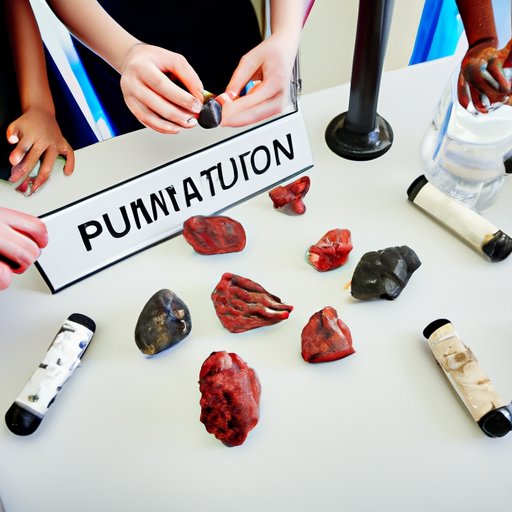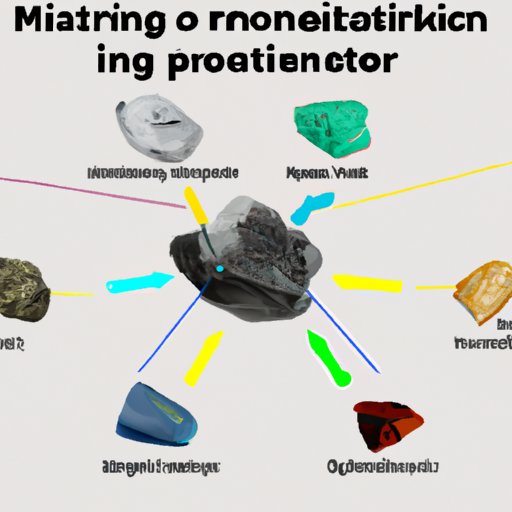Introduction
Minerals are naturally occurring substances found in rocks, soil, and water. They are essential components of the Earth’s crust, forming the basis of many types of rocks. Minerals are also important to human life, providing essential nutrients and trace elements for our bodies as well as playing an essential role in many industrial processes.
In this article, we will explore what minerals are, the different types of mineral properties, and how to identify them using their physical characteristics. We will also investigate the chemical composition of minerals, their role in human health, and their industrial uses.
What Are Minerals?
A mineral is a naturally occurring substance that has a definite chemical composition and crystalline structure. Minerals are formed in a variety of ways, from the cooling and solidification of molten rock to the precipitation of salts from water. They can also be formed by biological processes, such as the formation of shells and skeletons in organisms.
Minerals are classified according to their chemical composition and crystal structure. There are over 4,000 known types of minerals, but only a few hundred are commonly found in nature. These include quartz, mica, feldspar, olivine, calcite, and many others.

Exploring the Different Types of Mineral Properties
Minerals have a variety of physical and chemical properties. These properties can be used to identify different types of minerals and to understand their role in human health and industry.
Physical Properties
Physical properties of minerals include color, streak, hardness, cleavage and fracture, and luster. These properties can be used to identify different types of minerals and to determine their potential uses.
Chemical Composition
The chemical composition of minerals is determined by the elements and compounds they contain. This includes elements such as oxygen, carbon, magnesium, and silicon, as well as compounds like carbonates and oxides. Minerals can also contain organic compounds, such as those found in coal.
Role in Human Health
Minerals play an important role in human health. Many minerals, such as calcium and iron, are essential nutrients for our bodies. Others, such as zinc and copper, are present in trace amounts and are necessary for proper functioning of our cells.
Industrial Uses
Minerals are also important for industrial processes. They are used to make construction materials, such as cement and asphalt, as well as in manufacturing processes, such as steel production. Minerals are also used in electronics, pharmaceuticals, and many other industries.

How to Identify Minerals Using Their Physical Properties
The physical properties of minerals can be used to identify different types of minerals. These properties include color, streak, hardness, cleavage and fracture, and luster.
Color
The color of a mineral is determined by the elements it contains. For example, quartz is usually colorless or white, while olivine is typically green. The color of a mineral can vary depending on its environment, so it is important to consider other properties when identifying minerals.
Streak
The streak of a mineral is the color of its powder. It can be used to identify different types of minerals, as some have distinctive streaks. For example, the streak of quartz is white, while the streak of galena is gray.
Hardness
The hardness of a mineral is determined by its ability to resist scratching. It is measured using the Mohs scale, which ranges from 1 (very soft) to 10 (very hard). For example, talc has a hardness of 1, while diamond has a hardness of 10.
Cleavage and Fracture
Cleavage is the tendency of a mineral to break along certain planes. This can be used to identify different types of minerals, as some have distinctive cleavage patterns. Fracture is the tendency of a mineral to break along irregular surfaces. It can also be used to identify minerals.
Luster
The luster of a mineral is its ability to reflect light. It can be described as metallic (shiny), glassy (glossy), earthy (dull), or pearly (iridescent). For example, hematite has a metallic luster, while quartz has a glassy luster.
Understanding the Chemical Composition of Minerals
The chemical composition of minerals is determined by the elements and compounds they contain. Elements are the simplest forms of matter and cannot be broken down into simpler substances. Compounds are combinations of elements and can be broken down into their constituent elements.
Elements and Compounds
Most minerals contain one or more elements, such as oxygen, carbon, magnesium, and silicon. Some minerals also contain compounds, such as carbonates and oxides. The combination of elements and compounds determines the chemical composition of a mineral.
Minerals Containing Carbon
Some minerals, such as coal and graphite, contain large amounts of carbon. These minerals are important sources of energy and are used in various industrial processes, such as steel production and electricity generation.
Investigating the Role of Minerals in Human Health
Minerals play an important role in human health. They provide essential nutrients and trace elements necessary for our bodies to function properly.
Essential Nutrients
Minerals such as calcium, magnesium, and potassium are essential nutrients for our bodies. They help build strong bones, regulate fluid balance, and maintain healthy nerve and muscle functions.
Trace Elements
Minerals such as zinc, copper, and selenium are present in our bodies in trace amounts. They are necessary for proper functioning of our cells and are involved in many biochemical processes.

Studying the Industrial Uses of Minerals
Minerals are also important for industrial processes. They are used to make construction materials, such as cement and asphalt, as well as in manufacturing processes, such as steel production.
Construction Materials
Minerals are used to make a variety of construction materials, such as cement, concrete, and asphalt. These materials are used to build roads, bridges, buildings, and other structures.
Manufacturing Processes
Minerals are also used in manufacturing processes, such as steel production. Steel is made by combining iron ore with other minerals, such as carbon, manganese, and chromium. These minerals help to give steel its strength and durability.
Conclusion
Minerals are essential components of the Earth’s crust, providing essential nutrients and trace elements for humans and playing an essential role in many industrial processes. Minerals have a variety of physical and chemical properties, which can be used to identify different types of minerals and to understand their role in human health and industry.
In this article, we explored what minerals are, the different types of mineral properties, and how to identify them using their physical characteristics. We also investigated the chemical composition of minerals, their role in human health, and their industrial uses.
(Note: Is this article not meeting your expectations? Do you have knowledge or insights to share? Unlock new opportunities and expand your reach by joining our authors team. Click Registration to join us and share your expertise with our readers.)
